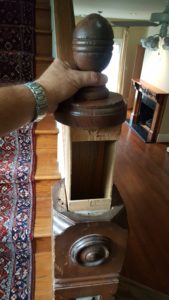Inspecting historic homes in New Orleans has its challenges and rewards.
The home may be in a historic area and subject to restrictions or regulations on alterations or repairs. The Vieux Carré Commission is a good example of a historic district. This commission preserves, protects and maintains the architectural, historic character and zoning integrity of the French Quarter. It does this by regulating all repairs, alterations, and construction of any building element on the exterior whether visible from the street or not. Owners not in compliance are charged with violations of the infractions. A sample of the Vieux Carré Design Guidelines.
Historic or older homes may not be up to current code or compliance since the building was built before these codes existed. We will use the stairs of an 1860’s Creole Townhouse as an example. The stairs were typically enclosed and positioned between the rear service wing and the main house. The rise and run of these older stairs may not meet today’s standards for compliance but are still functional. You definitely would not tear them down to build new ones. Below are some of the items as examples that differ in older homes.
Structure – Many historic homes in New Orleans were built with solid masonry walls unlike the brick veneers you find on newer homes. What this means is the solid brick wall is actually structural where the brick veneer is just a cladding. The brick veneer can be removed and the structure will still be standing, while a solid brick wall is removed the structure collapses.
Electrical – It’s not uncommon to find electrical wiring from different eras in the home. At times I come across the old gas lines in the attic used for gas lamps that hung from ceilings, more on this in the plumbing section. Many times I’ll find older knob and tube wiring (pre-1940) alongside older grey cloth wiring (1940-1955), aluminum wiring (1960-1970) and even newer Romex. Sometimes the older wiring is active and may be connected to newer wiring.
Plumbing – As mentioned above, the older gas lines used for gas lamps are sometimes still in place but most have been abandoned or capped. Galvanized supply lines can still be found and in use. Cast iron waste lines in the crawl space can still be found.
While these are not the only items inspected during a home inspection, they offer examples of the things we find. Every now and then we come across something cool like a secret hiding place like the one pictured in this newel post. The home it was found in was a Creole Cottage and built around the late 1700’s to early 1800’s.


